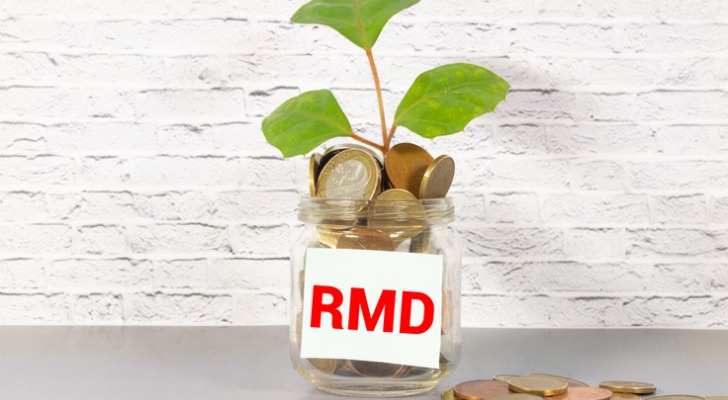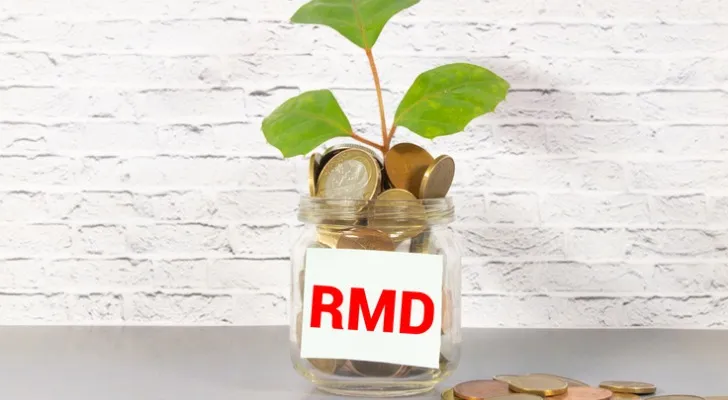Required minimum distributions (RMDs) are the mandatory withdrawals that you take from your tax-deferred retirement accounts each year. The IRS requires these distributions, even during rocky periods of life, and levies a penalty if you do not withdraw the mandatory amount every year. Fortunately, if you fail to take an RMD, you can avoid the looming penalty with a waiver letter. This is what you need to know about the RMD penalty with a waiver letter template to help preserve your nest egg.
For help with your RMDs and other retirement planning needs, consider working with a financial advisor.
What Is an RMD?
An RMD is the amount of money that individuals with pre-tax retirement accounts, such as traditional IRAs, 401(k)s and 403(b)s, must withdraw from their accounts each year once they reach a certain age.
The IRS mandates these distributions to ensure that individuals begin to withdraw and pay taxes on their retirement savings, which have typically been tax-deferred. However, Roth accounts are an exception, as they do not require RMDs during the original owner’s lifetime because taxes have already been paid on the dollars invested.
RMDs currently start at age 73 for people born between 1951 and 1959, and age 75 for people born in 1960 and later. You can calculate what you need to withdraw using the IRS RMD table.
Fortunately, you can delay your first RMD until April 1 of the year after you reach RMD age. Then, you must take all subsequent RMDs by December 31 each year thereafter. Therefore, it is essential for retirees to understand and comply with RMD rules to avoid penalties and ensure they take the appropriate distributions from their retirement accounts.
Designated and non-designated beneficiaries also have rules they must follow. Specifically, designated beneficiaries receive their own RMD calculation from the IRS and then must take distributions accordingly. On the other hand, non-designated beneficiaries must empty the account within 10 years of receiving it. Minor non-designated beneficiaries are exempt from this rule until they reach adulthood.
What Happens If You Miss Your RMD?
According to current tax regulations, missing your RMD incurs a 25% penalty on the distribution you were supposed to take. For example, if your RMD is $20,000, the penalty would be a maximum of $5,000 for not taking it. Remember, missing your RMD requirement results in a penalty on the amount not taken.
Amounts taken over the RMD threshold in the previous year do not count toward your RMD amount for the current year. If your incorrect or missed RMD is corrected within two years, the penalty drops to 10%.
What Is a Penalty Waiver Letter?
An RMD penalty waiver letter is a written request you submit to the IRS formally asking that the 25% penalty waiver be imposed for failing to take the required minimum distribution from your retirement account. This penalty waiver letter is specifically for those who missed the RMD deadline due to a reasonable cause and wish to avoid or reduce the penalty.
Steps to Take For a Missed RMD

If you have missed taking your RMD, there are some steps you should take immediately.
1. Withdraw the Money Now
If you realize you missed taking the RMD, withdraw it from your account immediately. Be sure to take enough for a lump sum so you can reach the RMD threshold. This will help you avoid an increase in your monthly distributions for that year.
2. File Form 5329 with the IRS
After receiving the funds, file Form 5329 with the IRS for every year that you missed your RMD. Remember, the form changes each year, so it is crucial that you download and complete the correct form for the corresponding year.
The IRS website supplies forms for 1975 and onward. These steps will help you correctly complete Form 5329 so you can report your missed RMD distributions to the IRS:
- Line 52: Write the RMD amount by account for each missed distribution.
- Line 53: Write the amount you withdrew. This figure may be $0.
- Line 54: Write 0 on this line. Then, write “RC” (abbreviation for reasonable cause) to the left of the line and the amount of the RMD shortfall. For example, if your RMD was $20,000 and you withdrew $5,000, the shortfall was $15,000.
- Line 55: Those requesting a penalty waiver will enter zero. In any case, taxpayers don’t have to pay the penalty upfront.
Once you have double-checked your entries, mail the completed form with your penalty waiver letter to the IRS.
Filing Form 1040-X to amend your taxes for the RMD is unnecessary. You will owe taxes on the amount you withdraw in order to satisfy the RMD for the year in which your plan administrator distributes the money.
RMD Penalty Waiver Letter Sample
Here’s a template to use when writing your RMD penalty waiver letter:
To Whom It May Concern:
On [the date you realized the RMD shortfall], while I was [activity at the time of discovery, such as reviewing your financial statements], I discovered that, for the tax year(s) [tax years for missed RMDs], the amounts of my distributions were insufficient to satisfy my Required Minimum Distribution.
The amount of the RMD shortfall for each year in question is as follows:
- Tax Year A: [Shortfall amount, such as $5,000]
- Tax Year B: [Shortfall amount, such as $2,000]
- [Etc.]
During the years listed above, I was unaware of the error(s), as I was [list reasonable cause, such as suffering from a severe physical or mental illness that prevented you from managing your finances properly]. Included is my physician’s report regarding the time of my illness.
Upon discovering my error(s), I took immediate and corrective action by taking the following distributions, as evidenced by the attached documentation:
- Document 1: [Document type, such as copies of checks, financial statements showing proof of transactions, etc.] dated [specific dates].
- Document 2: [Document type, such as copies of checks, financial statements showing proof of transactions, etc.] dated [specific dates].
- [Etc.]
As my filing history demonstrates, I do my utmost to remain compliant with IRS regulations. In the interest of preventing such errors in the future, I have decided to [list steps taken to prevent future errors, such as hiring a financial manager or increasing your monthly distribution from your plan administrator].
For these reasons, I believe my actions warrant a penalty waiver, and I am attaching Form 5329 to request that the penalties on my RMDs for years [insert relevant years] be waived.
Signed,
[Your signature and name]
Avoiding RMD Penalties
The simplest way to steer clear of RMD penalties is to create a dependable process for managing your annual withdrawals.
Many retirement plan providers offer automatic withdrawal options that can be set to occur monthly, quarterly or annually. This may help you meet the annual requirement without missing deadlines.
Keep in mind that your first RMD can be delayed until April 1 of the year after you reach RMD age, but each subsequent distribution must be completed by December 31.
Plan your retirement withdrawals more effectively using our RMD calculator.
Required Minimum Distribution (RMD) Calculator
Estimate your next RMD using your age, balance and expected returns.
RMD Amount for IRA(s)
RMD Amount for 401(k) #1
RMD Amount for 401(k) #2
About This Calculator
This calculator estimates RMDs by dividing the user's prior year's Dec. 31 account balance by the IRS Distribution Period based on their age. Users can enter their birth year, prior-year balances and an expected annual return to estimate the timing and amount of future RMDs.
For IRAs (excluding Roth IRAs), users may combine balances and take the total RMD from one or more accounts. For 401(k)s and similar workplace plans*, RMDs must be calculated and taken separately from each account, so balances should be entered individually.
*The IRS allows those with multiple 403(b) accounts to aggregate their balances and split their RMDs across these accounts.
Assumptions
This calculator assumes users have an RMD age of either 73 or 75. Users born between 1951 and 1959 are required to take their first RMD by April 1 of the year following their 73rd birthday. Users born in 1960 and later must take their first RMD by April 1 of the year following their 75th birthday.
This calculator uses the IRS Uniform Lifetime Table to estimate RMDs. This table generally applies to account owners age 73 or older whose spouse is either less than 10 years younger or not their sole primary beneficiary.
However, if a user's spouse is more than 10 years younger and is their sole primary beneficiary, the IRS Joint and Last Survivor Expectancy Table must be used instead. Likewise, if the user is the beneficiary of an inherited IRA or retirement account, RMDs must be calculated using the IRS Single Life Expectancy Table. In these cases, users will need to calculate their RMD manually or consult a finance professional.
For users already required to take an RMD for the current year, the calculator uses their account balance as of December 31 of the previous year to compute the RMD. For users who haven't yet reached RMD age, the calculator applies their expected annual rate of return to that same prior-year-end balance to project future balances, which are then used to estimate RMDs.
This RMD calculator uses the IRS Uniform Lifetime Table, but certain users may need to use a different IRS table depending on their beneficiary designation or marital status. It's the user's responsibility to confirm which table applies to their situation, and tables may be subject to change.
Actual results may vary based on individual circumstances, future account performance and changes in tax laws or IRS regulations. Estimates provided by this calculator do not guarantee future distribution amounts or account balances. Past performance is not indicative of future results.
SmartAsset.com does not provide legal, tax, accounting or financial advice (except for referring users to third-party advisers registered or chartered as fiduciaries ("Adviser(s)") with a regulatory body in the United States). Articles, opinions and tools are for general informational purposes only and are not intended to provide specific advice or recommendations for any individual. Users should consult their accountant, tax advisor or legal professional to address their particular situation.
When managing multiple retirement accounts, you can combine RMDs from different IRAs, but employer-sponsored plans, such as 401(k)s, must each meet their own withdrawal requirement. To help prevent mistakes, review your balances at the start of every year and calculate your RMD using the previous December 31 value.
Working with a financial advisor or tax preparer can also help ensure your distributions are calculated correctly and submitted on time.
Bottom Line

RMD shortfalls result in heavy penalties for the missed amount. Fortunately, Form 5329 allows you to appeal to the IRS for a penalty waiver. Sending a penalty waiver letter is a key part of your request, as it outlines your situation and explains why you missed your RMD. This is just another reason why it is crucial to keep detailed financial records so you are prepared when it comes time to file.
RMD Penalty Waiver Tips
- When navigating the tax landscape during retirement, a financial advisor with tax expertise can be a valuable resource. Finding a financial advisor doesn’t have to be hard. SmartAsset’s free tool matches you with vetted financial advisors who serve your area, and you can have a free introductory call with your advisor matches to decide which one you feel is right for you. If you’re ready to find an advisor who can help you achieve your financial goals, get started now.
- Receiving RMDs from your traditional IRA means a new tax bill. Here are the top 4 strategies for avoiding taxes on your RMDs.
Photo credit: ©iStock.com/Zorica Nastasic, ©iStock.com/Zolak, ©iStock.com/Nes
